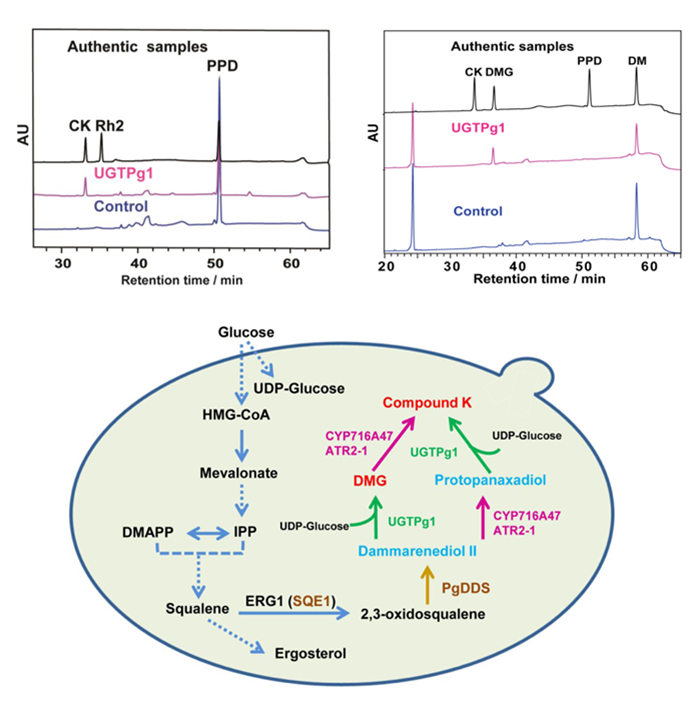Production of Bioactive Ginsenoside Compound K in Metabolically Engineered Yeast
Ginseng has been traditionally used as herbal medicine in Asia for thousands of years to enhance physical performance and to increase resistance to stress and aging. Its active constituents are ginsenosides, a group of triterpene saponins. More than 60 ginsenosides isolated from ginseng have been identified so far, however, the glycosyl-transferring step in their biosynthetic pathways remains unclear.
Compound K (CK) is the major ginsenoside-type metabolite detected in blood or organs after oral administration of ginseng in mammals and thus regard as the main function main functional component in vivo; it is reported to possess bioactivities of anti-inflammation, hepatoprotection, anti-diabetes and anti-cancer. CK was approved by the China Food and Drug Administration to commence clinical trials for arthritis prevention and treatment in 2013.
CK has never been identified in Panax plants, and is currently produced by bio-deglycosylation of protopanaxadiol (PPD)-type ginsenosides. However, such production is limited by the short supply of ginsenosides because successful cultivation of ginseng requires a long growth period and rotational tillage for replantation of Panax plants. Recently more and more attentions have been attracted to manufacture rare natural products by synthetic biology approach.
The research team led by Prof. ZHOU Zhihua and ZHAO Guoping from Institute of Plant Physiology and Ecology, Prof. YUE Jianmin from Institute of Materia Medica, Shanghai Institutes for Biological Sciences, Chinese Academy of Sciences unveiled the key enzyme (UGTPg1) which regioselectively and stereospecifically glucosylates the free C-20(S)-OH of dammarane-type triterpenoids. After co-expression of UGTPg1 with the PPD biosynthetic pathway in the chassis yeast, CK could be produced from cheap monosaccharide via microbial fermentation. A novel compound, 20S-O-?-(D-glucosyl)-dammarenediol II was discovered and identified in the CK producing yeast, which is readily converted to CK by a P. ginseng cytochrome P450 in vitro. Thus, two parallel pathways for CK production in the engineering yeast cell as well as in Panax plant are supposed. The ‘one-pot’ biosynthesis of CK in yeast provides not only a potential low-cost CK manufacturing method for its clinical applications, but also the scientific bases for understanding the biosynthetic pathways of ginsenosides in Panax plants.
This work entitled “Production of bioactive ginsenoside compound K in metabolically engineered yeast” has been published online in Cell Research on Mar 7. This research was Supported by National Basic Research Program of China (973 program, 2012CB721103), and the Knowledge Innovation Program from the Chinese Academy of Sciences (KSCX2-EW-G-13-1, KSCX2-EW-J-12).
Figure legend. Functional characterization of UGTPg1 and its application in the biosynthesis of compound K from monosaccharide in yeast. And two parallel pathways for CK production are detected in the engineering yeast cell (image by Prof. Zhou Zhihua’s group).
